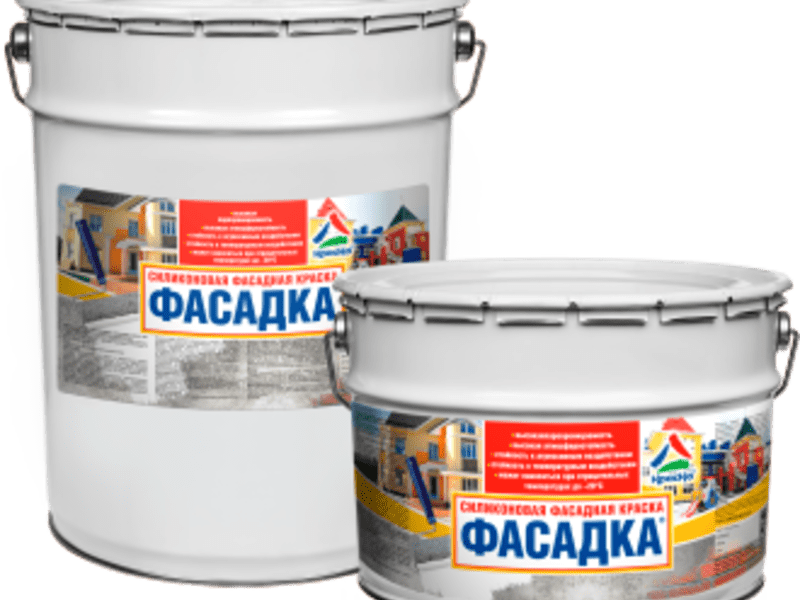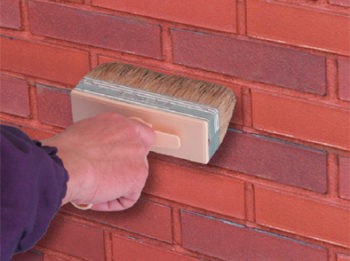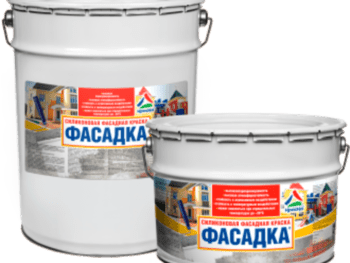Brick facades are well tolerated by the aggressive effects of external factors. But rains, frosts, winds and bright sunlight can have their destructive effect.
Brickwork can be subjected to mechanical damage, invasion of fungi and mold, sometimes due to improper production technology and laying of bricks, whitish spots - efflorescence - form on the surface of the brickwork.
To update the appearance, give decorativeness and additional protection, facade paints on brick are used.
Painting facades due to the large amount of work is a laborious and expensive process. The durability of the color depends on major facade paint properties.
Among them:
- water resistance- the ability to retain moisture on the surface, preventing it from penetrating deep into the material. If the coating allows water to pass through, when the temperature drops, the formed ice crystals will destroy the surface of the material. The surface will crack and the paint will peel off.
- resistance to sunlight- the ability to maintain color brightness when exposed to ultraviolet radiation. Facades on the south side are more susceptible to excessive solar radiation and may change color over time - burn out.
- vapor permeability- the possibility of moisture exchange between the wall material and the environment. With low vapor permeability, the wall surface will be constantly wet, fungi and mold will appear.
- wear resistance- the ability to maintain protective and decorative properties for a long time. The average durability of the color is about 5 years; compositions based on acrylic and alkyd resins can be used for more than 10 years without changing their properties.
- elasticity- an important characteristic, necessary to compensate for temperature changes during the change of seasons to avoid cracking of the coating.
- heat resistance- resistance to low temperatures, sometimes achieved by the use of special additives.
- alkali resistance- clay for making bricks and cement-sand mortars for masonry have an alkaline reaction, which is unfavorable for the paint composition. Alkali corrodes the paint, it may begin to bubble and lag behind the wall.
- decorative properties- the possibility of tinting and creating different reflective surfaces - matte, semi-matte or glossy. These qualities are necessary to give the building an elegant look, emphasizing architectural details and elements.
When carrying out painting work, important factors are technological characteristics:
- drying speed- the ability to dry quickly on the painted surface, which is important for outdoor work, because. the surface that has not yet hardened can be damaged by precipitation, depending on the ambient temperature.
- degree of adhesion- adhesion to the surface of the material, important when painting without priming. The greater the adhesion, the stronger the paint will hold, which will affect its durability.
- consumption per sq.m.- necessary for preliminary calculation of the need for paint, and also allows you to evaluate the cost-effectiveness of one type of paint over another.
- hiding power- the ability to paint over the previous or main surface color well.
Kinds
 Facade paints according to the binder are divided into:
Facade paints according to the binder are divided into:
- Acrylic. Produced on the basis of acrylic resins, the most suitable option for painting brick facades in terms of price-quality ratio. They form a durable moisture-resistant and vapor-permeable film on the surface that protects the brick from external influences. Does not allow salt stains to reappear. In addition, due to the high resistance of acrylic paints to alkalis, walls can be painted in a month.
- Water emulsion. They are a mixture of coloring pigments and water, which evaporates when dried. The base is usually lime. Such dyes are inexpensive, have high frost resistance and water resistance, resistance to solar radiation. Non-toxic and non-flammable.
- mineral. Produced on the basis of inorganic binders, they are environmentally friendly. Manufacturers produce lime, cement, silicate, oil paints.
- Epoxy. They vary in quality and features. Form a high-strength film, have good adhesive properties. But the painted surface needs additional protection, for example, varnish, due to instability to atmospheric precipitation.
- Silicone. High-quality paints, absolutely do not let moisture through, have good vapor permeability. They fit well even on a smooth surface with weak adhesion. Retain color for a long time.
Which one to choose for painting a brick facade
 External walls are often finished with facing bricks. Such a brick does not need additional coating.. But there are cases when it is necessary to paint the brickwork of silicate bricks.
External walls are often finished with facing bricks. Such a brick does not need additional coating.. But there are cases when it is necessary to paint the brickwork of silicate bricks.
For example, you want to update an old wall or emphasize a masonry element. Silicate brick consists of quartz sand and lime, so you need to choose a coloring composition with high alkali resistance. It is similar in properties to ceramic, i.e. clay, but less waterproof. Therefore, when choosing a paint composition, the main attention should be paid to moisture resistance.
Most often, acrylic paints are used for these purposes, which, in addition to high moisture resistance, have good vapor permeability, wear resistance and an affordable price. Silicate brick has a light surface, so it is possible the use of almost any color in the coloring. It should only be remembered that when repairing a painted surface, it is often impossible to change the color of the coating, because. the darker color will show through the lighter paint.
Consumption forecast for 1m2
- for acrylic paints, this figure is 150 g / sq.m,
- water-based paints have a consumption of 250-300 g / sq.m,
- mineral - about 200g / sq.m.
Consideration should be given to the absorbency of masonry, the number of layers of application and the method of painting. The lowest consumption is achieved when painting with an airbrush.
Thickened paints are diluted with water or a special solvent. In liquid form, ready to use.
To determine the total consumption for painting the facade, multiply the area of \u200b\u200bthe walls by the amount of consumption per sq.m.
Painting technology
 It is necessary to start painting the facade one year after masonry production. During this time, the materials will fade, dry out, and the alkalinity of the masonry mortar will decrease. The exception is acrylic paint, which can be applied to brickwork after a month.
It is necessary to start painting the facade one year after masonry production. During this time, the materials will fade, dry out, and the alkalinity of the masonry mortar will decrease. The exception is acrylic paint, which can be applied to brickwork after a month.
Facade painting includes preparatory work, painting and protection from debris getting on the freshly painted surface and getting wet.
Ground preparation is very important! If it is carried out incorrectly, facade paint will quickly lose its durability and decorative properties.
Outdoor work should be carried out in the warm season, prepare ladders, stairs or scaffolding, tools for applying a primer and a coloring composition - brushes, rollers or spray guns.
Preparatory work and cleaning
- You must first inspect the wall for efflorescence and dirt. Wash the wall with water. In the presence of greasy stains, detergents should be used.
- Repair defects in roofs and gutters.
- Necessarily remove old paint with a solvent.
- Repair chips and cracks with sealant or cement mortar. Subsequent work should be carried out only after the solution has dried.
- Treat the surface with herbicides for the destruction of moss spores, fungi and mold.
- Apply primer in 2-3 layers. Brick is not the most convenient and well-perceiving material for coloring, therefore it is desirable to prime the surface to increase the adhesion of the paint to the surface.
- If you have a grinder, grind the surface.
- Seal the contours of windows, doors and other elements around the perimeter with masking tape to avoid getting paint on them.
Facade painting
- Thoroughly mix the paint in the container, if necessary, add color according to the color scheme of the facade.
- Better to start from the top corner. Apply the first coat of paint vertically, making overlapping movements.
- Repaint after the first coat has dried.. Move the roller or brush horizontally.
- If necessary, apply a third coat of paint, creating an even painted surface.
 The final work is to protect the freshly painted facade from dirt and wetting. You can use a film for these purposes.
The final work is to protect the freshly painted facade from dirt and wetting. You can use a film for these purposes.
Maintenance of painted facades.
In order for the painted facade to please the eye for a long time, it is necessary to take care of it. Approximately once every six months, it is recommended to wash off the dirt from the surfaces and repair the damage that occurred during operation. You can simply tint the defects with the desired color.
Wall painting is the most unpretentious way to finish the facade. It allows you to improve both the decorative and operational qualities of brickwork. In addition, it is easy to do it yourself. The main thing is the correct choice of the coloring composition and the implementation of the coloring technology.
To buy a good frost-resistant paint, you will have to face the problem of choice. There are a lot of manufacturers on the paint market. The range is huge, each ...




